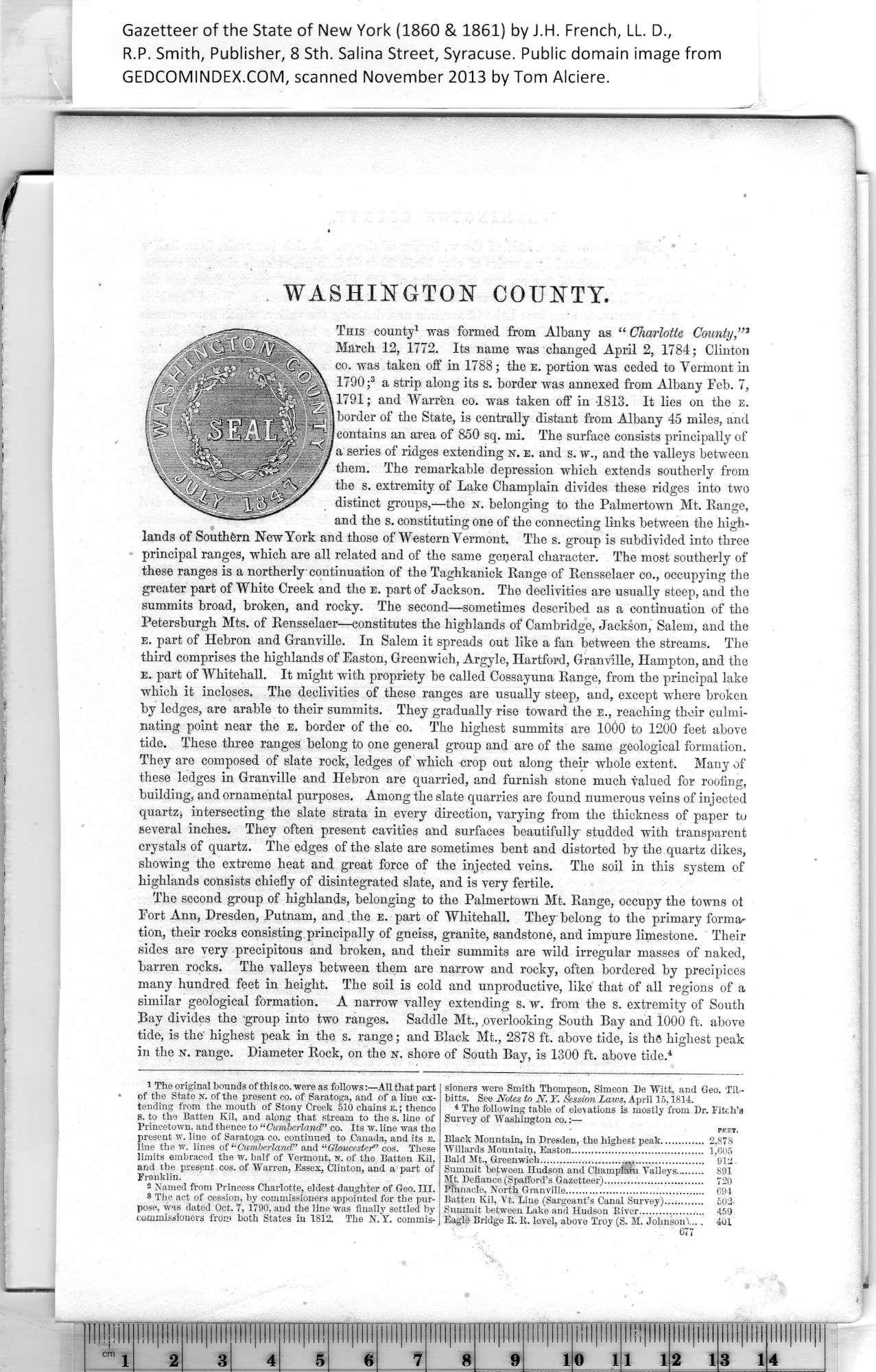|
WASHINGTON COUNTY.
This county1 was formed from Albany as “ Charlotte County,”*
March 12, 1772. Its name was changed April 2, 1784; Clinton
co. was taken off in 1788; the E. portion was ceded to Vermont in
1790 ;2 a strip along its s. border was annexed from Albany Feb. 7,
1791; and Warren co. was taken off in 1813. It lies on the e.
I border of the State, is centrally distant from Albany 45 miles, and
I contains an area of 850 sq. mi. The surface consists principally of
'a series of ridges extending n. e. and s. w., and the valleys between
them. The remarkable depression which extends southerly from
the s. extremity of Lake Champlain divides these ridges into two
distinct groups,—the n. belonging to the Palmertown Mt. Range,
and the s. constituting one of the connecting links between the high¬
lands of Southern NewYork and those of Western Vermont. The s. group is subdivided into three
principal ranges, which are all related and of the same general character. The most southerly of
these ranges is a northerly continuation of the Taghkanick Range of Rensselaer co., occupying the
greater part of White Creek and the e. part of Jackson. The declivities are usually steep, and the
summits broad, broken, and rocky. The second—sometimes described as a continuation of the
Petersburgh Mts. of Rensselaer—constitutes the highlands of Cambridge, Jackson, Salem, and the
e. part of Hebron and Granville. In Salem it spreads out like a fan between the streams. The
third comprises the highlands of Easton, Greenwich, Argyle, Hartford, Granville, Hampton, and the
E. part of Whitehall. It might with propriety be called Cossayuna Range, from the principal lake
which it incloses. The declivities of these ranges are usually steep, and, except where broken
by ledges, are arable to their summits. They gradually rise toward the e., reaching their culmi¬
nating point near the e. border of the co. The highest summits are 1000 to 1200 feet above
tide. These three ranges belong to one general group and are of the same geological formation.
They are composed of slate rock, ledges of which crop out along their whole extent. Many of
these ledges in Granville and Hebron are quarried, and furnish stone much valued for roofing,
building, and ornamental purposes. Among the slate quarries are found numerous veins of injected
quartz, intersecting the slate strata in every direction, varying from the thickness of paper to
several inches. They often present cavities and surfaces beautifully studded with transparent
crystals of quartz. The edges of the slate are sometimes bent and distorted by the quartz dikes,
showing the extreme heat and great force of the injected veins. The soil in this system of
highlands consists chiefly of disintegrated slate, and is very fertile.
The second group of highlands, belonging to the Palmertown Mt. Range, occupy the towns oi
Fort Ann, Dresden, Putnam, and the e. part of Whitehall. They belong to the primary format
tion, their rocks consisting principally of gneiss, granite, sandstone, and impure limestone. Their
sides are very precipitous and broken, and their summits are wild irregular masses of naked,
barren rocks. The valleys between them are narrow and rocky, often bordered by precipices
many hundred feet in height. The soil is cold and unproductive, like that of all regions of a
similar geological formation. A narrow valley extending s. w. from the s. extremity of South
Bay divides the group into two ranges. Saddle Mt., overlooking South Bay and 1000 ft. above
tide, is the highest peak in the s. range; and Black Mt., 2878 ft. above tide, is the highest peak
in the n. range. Diameter Rock, on the n. shore of South Bay, is 1800 ft. above tide.3
|
sioners were Smith Thompson, Simeon De Witt, and Geo. Tib-
bitts. See Notes to N. Y. Session Laws, April 15,1814.
* The following table of derations is mostly from Dr. Fitch’s
Survey of Washington co.:—
FRET.
Black Mountain, in Dresden, the highest peak............. 2,878
Willards Mountain, Easton........................................ 1,605
Bald Mt., Greenwich...........................v..................... 912
Summit between Hudson and Champlain Valleys .........891
Mt Defiance (Spafford’s Gazetteer).............................. 720
Pinnacle, North Granville........................... 694
Batten Kil, Vt. Line (Sargeant’s Canal Survey)............ 602'
Summit between Lake and Hudson Kiver ,...... 459
Eagle Bridge K. K. level, above Troy (S. M. Johnsonl.... 401 |
677
1
The original bounds of this co. were as follows:—All that part
of the State n. of the present co. of Saratoga, and of a line ex¬
tending from the mouth of Stony Creek 510 chains e. ; thence
s. to the Batten Kil, and along that stream to the s. line of
Princetown, and thence to “Cumberland” co. Its w. line was the
present w. line of Saratoga co. continued to Canada, and its e.
line the w. lines of “Cumberland” and “Gloucester” cos. These
limits embraced the w. half of Vermont, N. of the Batten Kil,
and the present cos. of Warren, Essex, Clinton, and a part of
Franklin.
2
8 The act of cession, by commissioners appointed for the pur¬
3
pose, was dated Oct. 7, 1790, and the line was finally settled by
commissioners from both States in 18l2. The N.Y. commis¬
|
